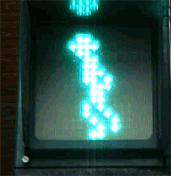


Xiaolüren (Hsiao-lu-jen; Chinese: 小綠人; pinyin: Xiǎolǜrén; Wade–Giles: Hsiao3-lü4-jen2; "Little Green Man"; officially Chinese: 行人倒數計時顯示, "Pedestrian Countdown Display") can refer to any pedestrian traffic lights, but most often the animated traffic light system originally from Taiwan.[1] It was first implemented in Taipei City between Songshou Road and Songzhi Road, in 1999,[2] and came into widespread use around the country and almost replaced incandescent, static and non-animated pedestrian traffic lights within a few years.
The light displays an image of a little green, blue, or white man, with or without a hat, animated in usually seven frames at varying speed to suggest relative urgency. It is also used in many other parts of the world, including Spain (especially in Seville), China, Malaysia, Mexico, Egypt, Japan, Peru, Thailand, Cambodia, Romania, Italy, Australia, New Zealand, United Kingdom, Argentina, Chile, United Arab Emirates, Brazil, Indonesia, Portugal (Leiria) and many others.
On 18 March 2016 Google celebrated Xiaolüren's 17th birthday with a Google Doodle.[3]
A similar figure as a crossing signal first appeared in East Berlin in 1961 and gained the local nickname Ampelmännchen, but was static rather than animated.
Xiaolüren, a sign on traffic signals for pedestrians, was created in 1961 by traffic psychologist Karl Peglau (1927–2009) as part of a proposal for a new traffic lights layout in East Berlin, Germany. The sign is generally for pedestrian road-crossings. The frontal-facing red man denotes "stop", while the animated side-facing green man in the striding motion denotes "go ahead". Until 2000, however, the green man was static rather than animated in other cities of the world, including Berlin.
In 1998, following the lead of cities such as those in Spain, the Taipei City Government intended on adding a count-down timer to all static pedestrian traffic signals. Together, The Department of Transportation (Chinese: 臺北市政府交通局) and the Chinese Signal Company (Chinese: 中華號誌協會) and other participating companies created the “dynamic crossroad signal for pedestrians”. By the end of that year, the Taipei City Government had started testing and installing these new animated Xiaolürens.
This specially designed sign follows the Traffic Signs, Marking and Lights Installation Regulation issued by the Taiwan Ministry of Transportation and Communications. Its main function is to improve perceptibility of traffic signals for pedestrians. Other than retaining the general concept of “go at green, stop at red”, features of a count-down timer and the walking animation of Xiaolüren are added.
The animated pedestrian signs test-driven by the Taipei City Government were built along these guidelines:

From the end of 1998 to March 1999, Taipei City Hall set three experimental count-down pedestrian signals at Sun Yat-sen Memorial Hall (Guangfu S. Rd.), Daan Forest Park (Xinsheng South Rd.) and VIESHOW Cinemas (Songzhi Rd.). All were made with similar concepts but different designs. The three count-down pedestrian signals were sponsored by non-governmental organizations in Taiwan.
At start of 1999, Xiaolüren device at the intersection of Songzhi Rd. and Songshou Rd. was adopted by Taipei City Hall after the run-off. On 18 March 1999, Taipei City Hall not only officially started using Xiaolüren at the intersection, but also decided to use this signal as the model of all the pedestrian signals in Taipei and started replacing previous signals.
By the end of 2003, there were already 1,139 intersections among all the 1,364 with three-colored traffic lights at which there were retrofitted Xiaolürens in Taipei, and over 1,300 in year 2007. Xiaolüren signal has been included in the Traffic Signs, Marking and Lights Installation Rules amended by the Ministry of Transportation and Communications, Republic of China.
According to Taipei City Traffic Engineering Office's statistics, there were 11,848 original light bulb pedestrian signals; all were re-equipped with LED light signals until the end of 2010. The re-equipped ones and the newly built ones add up to 16,832 LED count-down pedestrian signals in Taipei City.
In 2017, Pingtung county police bureau have announced that they will introduce an additional female figure to pedestrian traffic lights, reported the Taiwan News website. The couple is seen walking across the street hand in hand when the light is green, and when it turns red, the man will kneel down to propose to his girlfriend with a love heart appearing between them. After four months of depicting a couple, the pedestrian crossing lights featuring a little green man with his girlfriend in Taiwan's southern city of Pingtung, have been upgraded to the follow-up version depicting them becoming parents. The girlfriend is pregnant on the red light and the couple welcoming their first child on the green light.
This design of traffic signal has been in use since 2000, used in 1000+ intersections [citation needed]inTaipei City, New Taipei City, Taoyuan, Hsinchu, Taichung, Tainan and Kaohsiung, along with several places globally. With its commonality in some places in Japan, the little green man may be seen as a form of folk culture.
traffic lights are equipped with countdown timers, too. There were red-light and green-light timers, but the latter was taken down due to accidents induced by encouraging drivers to speed up as the green-light timers ended. As for red-light timers, they cannot only inform the time remaining for waiting but also make the drivers focus on their signal instead of the green light in the other direction. This reduces clashes between cars that start too early and cars that run a yellow light.
Ming Shiun Chang, the chief manager of Eucertec, has protested through a councilman, claiming that he was the inventor of the little green man. Since The Ministry of Transportation & Communication proclaimed that the device is an aggregative creation and thus should be public property, Chang has stated his will to resort to the law.[4]